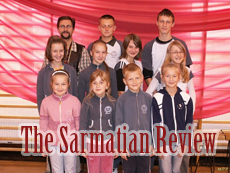| This Issue | Back Issues | Editorial Board | Contact Information |

Anioł w poezji baroku. Dzieje postaci w kulturze dawnej Europy
Anna Nowicka-Struska
By Danuta Künstler-Langner. Toruń: Wydawnictwo Naukowe Uniwersytetu Mikołaja Kopernika, 2007. 231 pages. ISBN 978-83-231-2124-4. Paper. In Polish.
Writing about angels in art is a major challenge. How can one reconcile the image of a chubby angel from the cover of the book by Professor Danuta Künstler-Langner with the imperious cherubs immobilised in Byzantine frescos, or the guardian angel in the hour of death with St. Michael’s sword in the valley of decision on Judgment Day? This angelic diversity in Old Polish and European literature and culture is the focal point of the latest study by the eminent scholar from Toruń.
The work is a carefully structured lecture on how knowledge, representation, and theology of angels developed, and is aimed at reconstructing the image of “God’s envoy as the intermediary between the sacrum and the profanum” (7). Künstler-Langner has long been recognized as a scholar who takes an interdisciplinary approach to investigating cultural phenomena and presents Polish literature in the context of the Mediterranean universum (as evidenced by her books Idea vanitas, jej tradycje i toposy w poezji polskiego baroku [1996] and Człowiek i cierpienie w poezji polskiego baroku [2002]). Like her previous works, this book is not an analysis of Polish Baroque poetry focusing on minute technical details, but rather an attempt to show theology, spirituality, and poetry acting together in the presentation of angels throughout centuries. A methodological purist may find it irritating to see some inconsistencies and an apparent dilemma already in the title of the study. The Angel in Baroque Poetry and the subtitle The History of the Figure in Old European Culture seem inconsistent, but in fact they suggest the scale of the entire undertaking.
The introduction outlines the evolution of angelological thought starting from the early Christian texts and decisions of the Church Councils. In chapter 1 Künstler-Langner analyzes a variety of terms and definitions of angels that in her view account for the diversity of their representation. Following the history of the angelic figures, she touches on the Bible and the Egyptian, Zarathustrian, and Talmudic sources including the Qumran scrolls. According to the Gnostics angels, together with eons and demiurges, are intermediaries between God and human beings. There are similarities between God’s biblical envoys and the Babylonian and Assyrian winged specters. The Pythagoreans believed that souls-demons residing in the air are responsible for our dreams. Angels are important to both Christians and Muslims, a point made by the author while discussing the biblical hosts of archangels. In the New Testament angels are heavenly envoys (25). Künstler-Langner also discusses apocryphal texts, noncanonical gospels, epistles, and other writings. This chapter ends with a review of texts by the Fathers of the Church Justinian, Origen, and Augustine, as well as treatises by Pseudo-Dionysius the Areopagite; Isidore of Seville; and the enigmatic works by Hermas, one of the Essenes.
Chapter 2 is titled “Bonus angelus in Medieval Literature and Culture.” It is devoted to the writings of St. Hildegard of Bingen, St. Bonaventura, St. Thomas Aquinas, and the twelfth-century masters of contemplation, St. Gertrude of Helfta and Mechthild of Magdeburg. Künstler-Langner then analyzes representations of angels in the visual arts, sermons, religious songs, and early medieval poetry. Finally, the author concentrates on Polish apocrypha, mostly dating from the sixteenth century but “in terms of the subject matter deeply rooted in medieval interpretations of the Bible” (88). Not surprisingly, these reflections lead to Dante’s The Divine Comedy.
Chapter 3 revolves around the key figures of Catholic spirituality such as St. Teresa of Avila and St. Ignatius of Loyola, then discusses the Polish and European humanists whose works contain angelological reflections. This part of the study ends with some noteworthy examples of angels in literature and the influence of Petrarch’s writings on Jan Kochanowski’s works.
The next chapter, “Baroque Theatrum Angelorum. Winged Heroes of the Polish Baroque Poetry,” is central to the dissertation since this is precisely what interests the author most. Once again she returns to Spanish mysticism and Ignatian spirituality, showing how they influenced Polish poetry, especially the works by Mikołaj Sęp-Szarzyński, Sebastian Grabowiecki, Kasper Twardowski, Kasper Miaskowski, and Jan Žabczyc. These works are a clear indication of the importance of angels in the artistic mind of the epoch. The part of the study devoted to the symbolism of the Polish Baroque is of special pertinence. Here the reader is taken on an intellectual trip that stops at the works of Zbigniew Morsztyn, Marcin Hincza, Aleksander Teodor Łącki, and Stanisław Herakliusz Lubomirski. Books of emblems, a combination of allegorical pictures and explanatory poems, are also vibrant with sound—musica mundane and musica coelestis (this is shown in the analyses of texts by Morsztyn). In Polish Baroque poetry, angels occupy the sacred space synonymous with a divine homeland and a higher form of human existence. This chapter reveals a wide variety of “functions” performed by angels, who are employed by the Polish Baroque poets to meditate on divine love, philosophy, and ethics. The angelological picture of seventeenth-century Polish poetry is supplemented by Maciej Kazimierz Sarbiewski’s lines illustrating the boundless longing for the divine homeland in the visions of Klemens Bolesławiusz and Józef Baka.
The main focus in chapter 5 is on English metaphysical poetry, the French poetic muse of “the burning island,” and the seventeenth-century emblem books that fall under the category of amor divinus. This discussion places the previous analyses of Polish literary texts in a wider context.
The final chapter is devoted to angelic issues in the visual arts. It deals with the various ways that angels are presented in icons.
The book is written in a language devoid of scientific jargon. The interdisciplinary approach as well as the time span of the material presented are perhaps the biggest assets of this unusual and important study. ◊
Back to the January 2010 Issue
The Sarmatian Review
sarmatia@rice.edu
Last updated
2/22/10